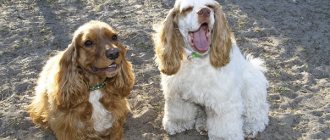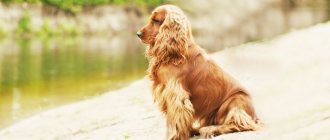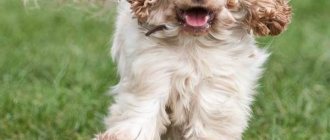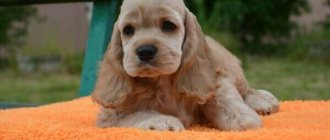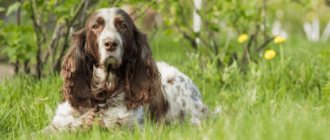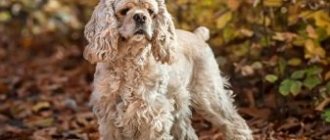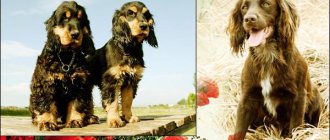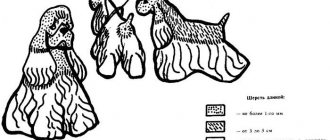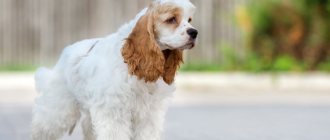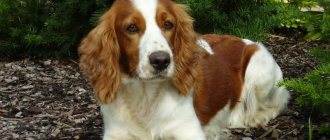Walk
The English Cocker Spaniel, like its American counterpart, loves long walks and is happy to run in any weather.
An adult cocker needs to be walked twice a day for one and a half to two hours.
But you shouldn’t be outside in rainy weather for more than half an hour. For walking you will need a long leash with a tape measure. You cannot let the dog go: a cocker can chase a cat, following its hunting instincts, and the screams of its owner will not stop it. Closed areas or enclosures are suitable for free walking.
A cocker must get used to a leash from childhood. The collar for the puppy is selected so that two fingers fit between it and the baby’s neck. As it grows it changes to a larger size. A cocker collar should be wide, light and soft. Products made from textiles or soft leather are suitable. Harnesses are contraindicated for a dog of this breed.
The puppy may get tired while walking. Nothing bad will happen if the owner picks him up and carries him for some distance.
By the age of six months, cockers develop joints and skeletal bones. They are not allowed to go up and down stairs, jump over barriers or jump from heights.
It is important to remember that walking your dog in public places is only allowed with a muzzle and a short leash.
What diseases can occur in pets?
Each description of the breed emphasizes that cocker spaniels are distinguished by excellent health and great physical activity. But this breed has several weak points - ears, eyes, tail and hip joint. In addition, due to high activity, the dog can be injured. If the animal does not receive enough physical activity, there is a risk of obesity. Proper care and education helps reduce the risk of disease. It is advisable to undergo regular checkups with a veterinarian.
The Cocker Spaniel is a companion for hunting, outdoor activities and city life. The dog does not like to be bored, but it is very obedient and, with proper training, gets along well with children and does not show aggression towards other animals.
Feeding
The English Cocker Spaniel, like the American Cocker, is unpretentious in food. He can eat anything. For a dog to live a long and fulfilling life, its diet must be balanced, taking into account activity.
Feeding the puppy
Feeding your Cocker Spaniel at a certain time and in a strictly designated place will help accustom him to routine and order.
Until the age of two months, the baby is fed six times a day. From two to four months, the number of feedings is four to five times. By six months, a grown puppy can be fed three to four times. By the age of ten months, the pet is transferred to two meals a day. And this regime remains constant.
Feeding an adult dog
There is an opinion among some breeders that an adult cocker can be fed once a day. It is worth disproving such a theory. It is better to divide the dog’s diet into two equal portions and feed it in the morning and evening, with an equal time interval. With this scheme, nutrients enter the body evenly.
Cockers are prone to gluttony. Appetite must be controlled.
Bathing
To keep your dog clean, it is not necessary to bathe it every time it gets dirty.
It is enough to brush regularly with a soft brush. If you bathe frequently using detergents, your dog may experience itchy skin and flaking. Shampoo and soap destroy the fat layer, which naturally protects the skin from dirt and moisture. This is especially true for puppies under six months of age. You can bathe your puppy using homemade shampoo, consisting of kefir or curdled milk, egg yolk and warm water. This composition will not damage the protective layer. If the pet is dirty and the dirt cannot be washed off with a home remedy, then shampoo for long-haired dogs is used. It is diluted with warm water in a 1:1 ratio.
Paws and ears are washed every time you return to the house. The puppy must be taught this procedure from an early age.
Required Tools
To cut your hair at home you will need the following tools::
- Regular scissors
- Thinning scissors.
- Hair clipper.
- Trimming knife.
- Bath towel.
Many professional groomers believe that the best trimming is obtained by pinching the coat by hand, rather than using a trimming knife, which, while removing fluff, can damage the guard hairs.
Grooming
The Cocker's luxurious coat requires careful attention.
Grooming an English Cocker Spaniel is easier than caring for an American Cocker. The Englishman's coat is not as thick as the American's. Therefore, the haircut of an English cocker will be different from that of an American. Otherwise the differences are unnoticeable. How to care for the coat: on your own or with the help of a groomer, depends on the skills of the owner. For a beginner, it is better to go through the first care activities in a salon. Subsequent manipulations can be performed independently, having an idea of proper care.
Grooming includes the following:
- Combing and combing.
- Timely haircut.
- Trimming as needed.
A haircut
Basic standards for cutting a spaniel in a comparative table.
| American Cocker | English cocker | |
| Head | Short shaved hair on the skull and upper neck. The upper third of the ear and cheeks are also shaved, as is part of the muzzle around the eyes. | Short-cropped coat, no bangs. |
| Torso | The fur on the back is cut as short as possible and all undercoat is removed. The upper part of the neck and back is stripped. A machine is used to trim the tail. | In the chest area the fur is cut short; a triangular area above the chest is left untouched; wool is trimmed on the croup; the area around the anus is cut very short in the shape of a quadrangle. |
| Legs | Limbs are not subject to haircuts. Only the paw pads are trimmed. | On the front legs, the hair on the front and sides is cut short, leaving long hair on the back. Hindquarters: The upper thigh remains covered with long hair. From the hock to the paw, the coat is cut as short as possible. |
Combing
The Cocker needs to be brushed daily. After all, not only the appearance of the dog depends on how to care for the coat. When combing, dead hairs are removed, the skin receives a kind of massage, blood circulation improves, and metabolism accelerates.
It is necessary to accustom a dog to a comb from puppyhood, then this procedure will bring pleasure to both the owner and the pet.
Breed varieties
Since the creation of the English Spaniel Club, specialists have been constantly working to improve the animals’ exterior. Thus, new varieties of the breed were developed, differing in several criteria.
According to their purpose, cocker spaniels are divided into 2 groups:
| Exhibition | Hunting |
| Appeared as a result of selection work after hunting | They are represented predominantly by white spaniels (they are better visible in the grass) |
| Longer ears and coat | Have shorter hair |
| The tail is up to 10 cm long or remains undocked | Tail length does not exceed 13 cm |
Depending on the time and place of origin of spaniels, the following types are distinguished:
- Springer Spaniel. Belongs to one of the oldest breeds and is an excellent companion. The Springer Spaniel grows up to 51 cm at the withers. The coat is black or brown and white.
- English toy spaniel. Due to its small size (up to 5–6 kg in weight and 28 cm in height), the English Toy Spaniel is considered one of the smallest spaniels. Primary colors are Blenheim, Ruby, Black and Tan, Tricolor. Depending on the color, the name of the breed “English Toy Spaniel” may sound different: King Charles Spaniel or Prince Charles Spaniel, Blenheim. The English Toy Spaniel is extremely intelligent and very loyal to its owner. Mini representatives of the breed are the most valued.
- Field Spaniel. Classic hunter. It can be up to 47 cm high and weigh about 25 kg. Basic colors: roan, roan blue, black or brown.
- Welsh Springer Spaniel, or Welsh Springer Spaniel. Hardy, noble hunting dog. At the withers, the Welsh Springer Spaniel reaches 48 cm, and in weight - 20 kg. Since the 8th century it has been common on the Scottish coast and the territory of Wales. The classic color of the Welsh Springer Spaniel is red with white spots. If there are children or animals in the house, the Welsh Springer Spaniel gets along well with them, but needs careful training.
- Clumber Spaniel. A heavy animal (about 34 kg), white with lemon or orange spots. Very strong.
This is interesting! The main difference between spaniel varieties is their size. For example, dwarf representatives of the breed include the Japanese Chin, Papillon, and Tibetan Spaniel.
Color and coat type
According to the FCI standard, the English Cocker Spaniel breed can have several types of colors: spotted, solid, tricolor or speckled.
Solid (one-color) include:
- black English Cocker Spaniel;
- golden;
- red cocker spaniel;
- chocolate;
- brown cocker spaniel;
- red
Important! Spots with this type of color are not allowed (only a small white on the chest).
The spotted coloring patterns of Cocker Spaniels include:
- black and white;
- red and white;
- liver-white;
- fawn-white.
The tricolor color can be black, white and tan or chocolate, white and tan.
Speckled coloring, or "roan", suggests the following colors:
- ginger;
- blue (maybe with tan);
- pale yellow;
- hepatic;
- chocolate with tan.
Attention! Other color combinations do not belong to the breed standard.
Representatives of the breed are smooth-haired dogs with close-fitting, soft hair. On the lower part of the animal’s body, the fur forms a kind of “skirt”.
Ear care
Spaniel ears require special care. Long ears are poorly ventilated and are therefore susceptible to fungal diseases and inflammatory processes. It is necessary to clean the ears from wax and dirt once every 2-3 days, using a damp cotton swab. Clean the outer part of the ear canal. You can’t go deep inside - you can damage the cocker’s delicate ear.
In spring and summer, the main problem is ticks. If your pet behaves restlessly, shakes its head, or tries to scratch its ears with its paws, it means there is a tick there.
Daily inspection of the inner and outer parts of the ear is necessary.
Parasites removed in time will not be able to penetrate deep into the ear canal.
The long ears of the Cocker Spaniel collect all debris, especially burrs. If there is a walk in the forest, the dog is given a special cap for the spaniel ears. This will make grooming easier.
Dental care
To accustom a puppy to examining and brushing his teeth from an early age, he is taught the “Show your teeth” command. This will come in handy when the dog begins to participate in exhibitions, because a dental examination is a necessary item.
Dental care is carried out regularly once a week, starting from the age of six months, after the complete replacement of milk teeth with permanent ones.
To do this, use a soft toothbrush and toothpaste for dogs to clean the teeth with gentle movements. Soft plaque on teeth can be removed with a cotton swab dipped in water. But tartar in dogs is difficult to remove on your own. To carry out this procedure, contact a veterinarian. The formation of tartar is dangerous because it can cause inflammatory gum disease.
As a natural way to clean the teeth, the spaniel is offered to gnaw on large bones and cartilage. Caring for and maintaining healthy teeth is a prerequisite for maintaining the health of your pet.
Puppy care
Features of maintenance and care include teaching your four-legged friend the basics of training and education. Classes should be regular, timely, and take place in a playful environment. Caring for and raising a puppy is long and painstaking work. The owner's tolerance and personal contact contribute to rapid success in practicing and consolidating skills.
Toilet training
One of the problems that the owner faces with the appearance of a pet is how to accustom the puppy to fulfill its natural needs. At first, while the cocker is small and there are no scheduled vaccinations, going outside is prohibited. Toilet training a spaniel is not difficult.
Having discovered the area where the dog most often does his dirty deeds, the area is covered with newspapers or a disposable medical diaper. These porous materials will quickly absorb dirt. If you notice that the puppy begins to sniff and behave restlessly, you should take the baby to this place. Not everything will work out the first time; most likely, the puppy will want to run away. At this moment, it is worth being persistent and making sure that he recovers in the right place.
A small cocker will quickly get used to a diaper if you take him to the toilet after eating and sleeping. Be sure to praise the puppy after he has returned to the right place.
A spaniel puppy at the age of 3 months can already go outside for walks. It happens that, having gotten used to the diaper, the dog does not want to recover on the street. In this case, you need to take the soiled newspapers outside, thus making it clear what the cocker should do.
Cockers are quite clean animals. There should be no difficulties in toilet training a spaniel. An exception may be an emotionally unbalanced dog. He is able to urinate out of fear or out of joy. In this case, you need to contact a veterinarian. Perhaps it is worth reconsidering the owner’s attitude towards the dog: if abused, the dog can do its dirty deeds to spite the person.
Leash training
Another significant point in training and care is how to teach a cocker to walk on a leash. The breed is characterized by increased activity, and an adult dog that does not know how to walk on a leash can cause many unpleasant moments for the owner in the future. Before going outside, the command “Walk!” is given in a voice, then a leash is fastened.
You should not allow your puppy to chew on the leash or use it for play. If the puppy resists walking on a leash, you should attract his attention with a treat, forcing him to move in the right direction.
After the walk, the leash is unfastened, and the collar remains on the neck. Be sure to reward with a treat after a successful walk.
Puppy training
The peculiarities of training a cocker puppy include feasible loads. The baby is constantly on the move and finds it difficult to sit still for a long time. The educational process takes place for the spaniel in a playful way, and for a short time.
Physical punishment is strictly prohibited. Cockers are touchy by nature.
The pet does not follow the command not because it does not want to, but because it cannot understand what is wanted from it. The method of rewarding a correctly executed command with a treat will speed up the learning process.
Raising and training dogs
The English Cocker is a smart dog, and thanks to this intelligence it is easy to train. Usually, until the age of three months, it is not recommended to apply too harsh measures to the dog, otherwise its psyche will suffer. During this period, the dog should not listen to too many different commands.
Then more active activities begin. At first, dogs are taught only simple commands that they remember quickly. Be sure to let them get used to the fact that the head of the house is the owner. When weakened, the dog quickly becomes stubborn and strives to dominate. On the contrary, rudeness and aggression traumatize the animal. A reasonable combination of rigor and praise, encouragement for correctly performed exercises, is enough.
It is better to socialize the dog from an early stage, then it will not attack cats, other pets, or people. It is worth training a cocker to hunt game from the age of 7-8 months. The easiest way is to contact a dog handler, after which the dog will easily pick up the trail, look for the bird, and flush it out correctly.
Physical activity for dogs
Puppies and adult animals need to be allowed to run, play, and frolic regularly - they are unable to simply sit at home. If you rarely walk your dog, it will become sick and suffer from obesity. The ideal option is to walk up to 2-3 hours a day.
The activity of the English Spaniel gives him the opportunity to participate in various types of dog sports - agility, frisbee, flyball. Athletes can jog with their pet. In summer, the dog should be allowed to swim in ponds; the cocker is an excellent swimmer. Hunting will also be a good way to exercise. It is only important to control the dog’s movements: it can get carried away and confuse serious actions with play. But after proper training, an English spaniel will quickly find game, track it and scare it at its owner, which will greatly simplify hunting.
Caring for an Elderly Cocker
The average lifespan of cockers is 11-12 years. By the age of 9, animals’ vision deteriorates and their hearing decreases. The elasticity of the ligaments is no longer the same as in a young animal, the bones become fragile. Walks become more relaxed. The owner may have to lift the dog in his arms to climb flights of stairs. After all, such a task becomes difficult for an aging dog.
To maintain the vital functions of the pet, multivitamin complexes are used for aging dogs. The diet is also subject to revision. It is recommended to purchase food for older animals.
Knowledge of how to care for an American or English cocker will help you raise a healthy and active pet that will delight its owner.
